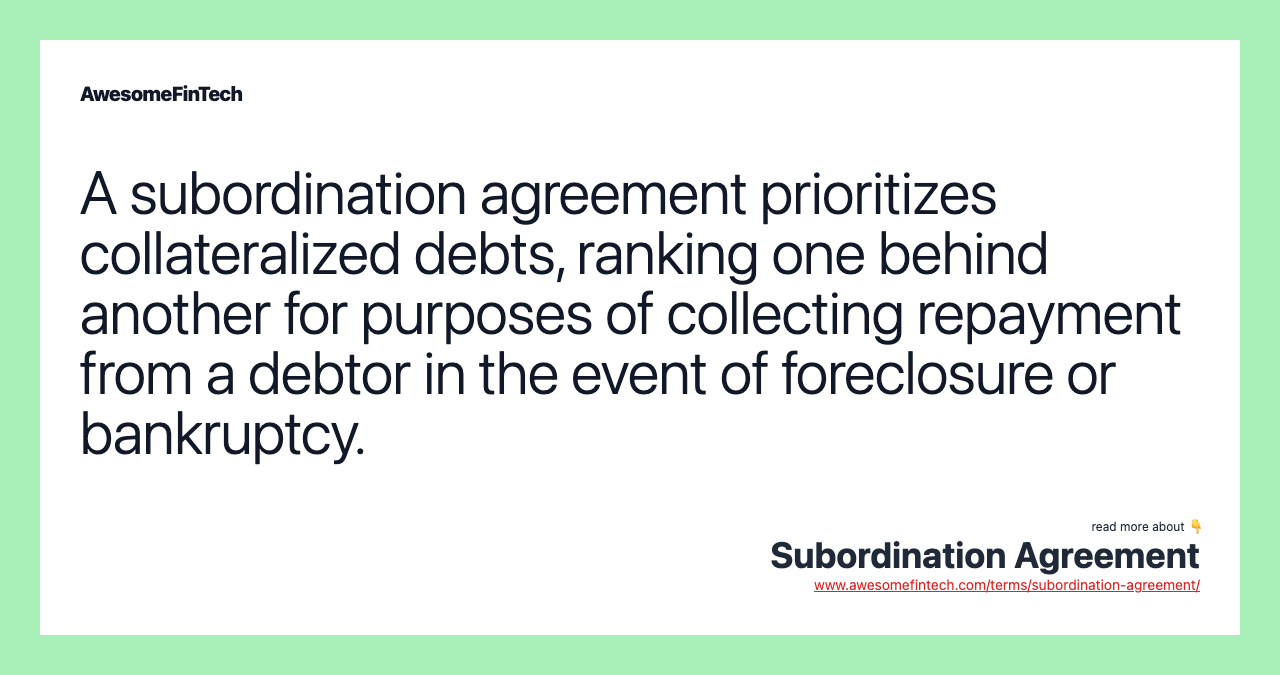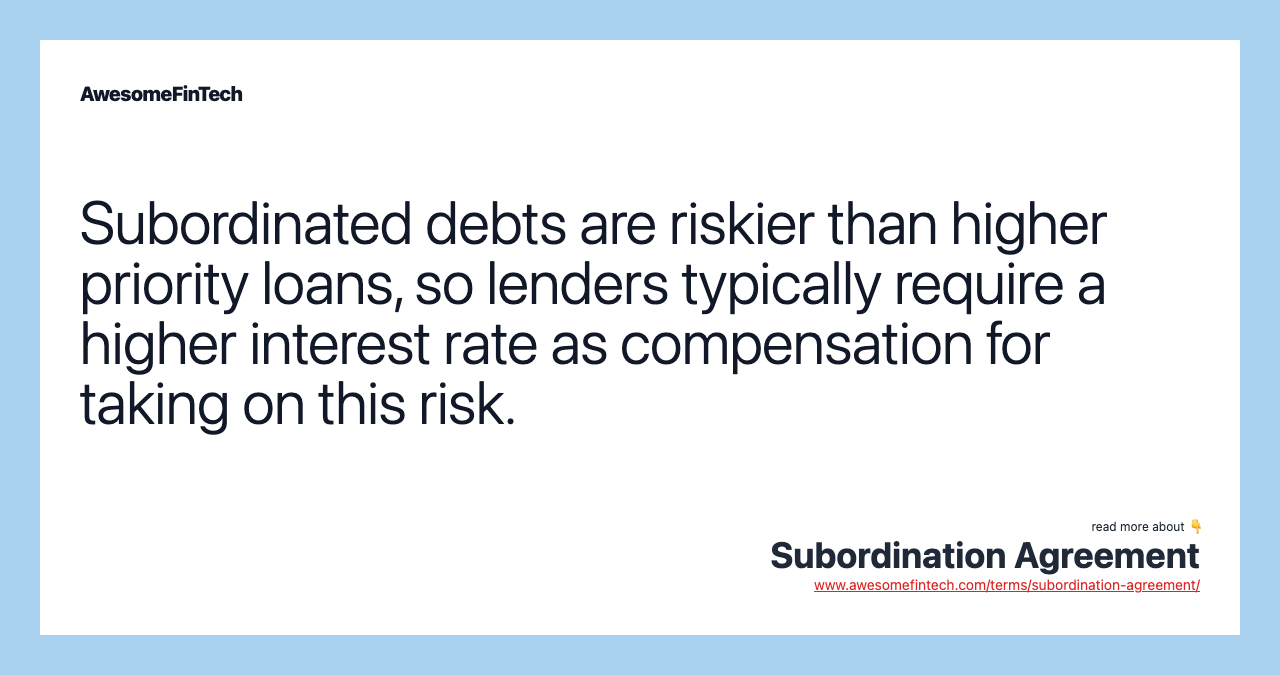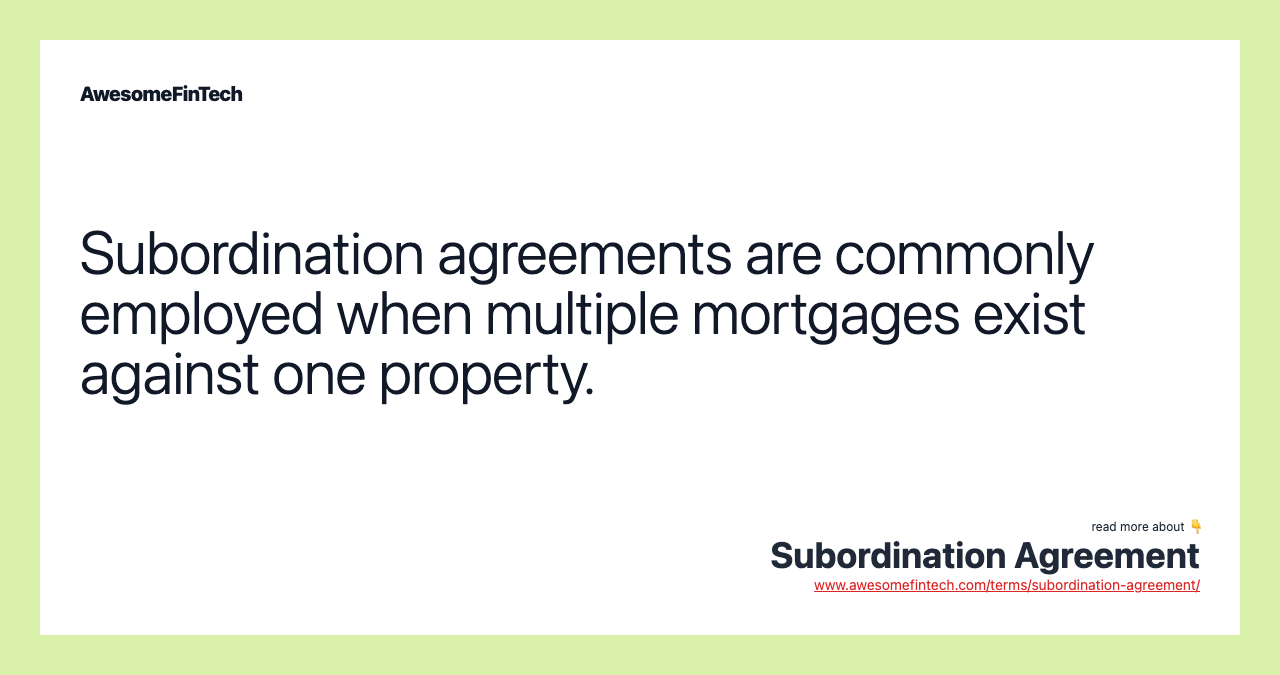Subordination Agreement
A subordination agreement is a legal document that establishes one debt as ranking behind another in priority for collecting repayment from a debtor. The lender of the first mortgage refinancing will now require that a subordination agreement be signed by the second mortgage lender to reposition it in top priority for debt repayment. When an individual takes out a second mortgage, that second mortgage has a lower priority than the first mortgage, but these priorities can be upset by refinancing the original loan. A subordination agreement acknowledges that one party’s claim or interest is superior to that of another party in the event that the borrower's assets must be liquidated to repay the debts. Subordinated debts are riskier than higher priority loans, so lenders typically require a higher interest rate as compensation for taking on this risk.

What Is a Subordination Agreement?
A subordination agreement is a legal document that establishes one debt as ranking behind another in priority for collecting repayment from a debtor. The priority of debts can become extremely important when a debtor defaults on payments or declares bankruptcy.
A subordination agreement acknowledges that one party’s claim or interest is superior to that of another party in the event that the borrower's assets must be liquidated to repay the debts.
The subordinated party will only collect on a debt owed when and if the obligation to the primary lender has been fully satisfied in the event of foreclosure and liquidation.




How a Subordination Agreement Works
Individuals and businesses turn to lending institutions when they need to borrow funds. The lender is compensated when it receives interest payments on the loaned amount, unless and until the borrower defaults on her payments. The lender might require a subordination agreement to protect its interests should the borrower place additional liens against the property, such as if she were to take out a second mortgage.
The "junior" or second debt is referred to as a subordinated debt. The debt which has a higher claim to the asset is the senior debt.
Lenders of senior debts have a legal right to be repaid in full before lenders of subordinated debts receive any repayments. It often happens that a debtor doesn't have enough funds to pay all debts, or foreclosure and sale doesn't produce enough in the way of liquid proceeds, so lower priority debts might receive little or no repayment at all.
A subordination agreement acknowledges that one party’s claim or interest is superior to that of another party in the event that the borrower's assets must be liquidated.
Example of a Subordination Agreement
Consider a business that has $670,000 in senior debt, $460,000 in subordinated debt, and total asset value of $900,000. The business files for bankruptcy and its assets are liquidated at market value — $900,000.
The senior debtholders will be paid in full, and the remaining $230,000 will be distributed among the subordinated debtholders, typically for 50 cents on the dollar. Shareholders in the subordinated company would receive nothing in the liquidation process because shareholders are subordinate to all creditors.
Subordinated debts are riskier than higher priority loans, so lenders typically require higher interest rates as compensation for taking on this risk.
Types of Subordination Agreements
Subordination agreements can be used in a variety of circumstances, including complex corporate debt structures.
Unsecured bonds without collateral are deemed to be subordinate to secured bonds. Should the company default on its interest payments due to bankruptcy, secured bondholders would be repaid their loan amounts before unsecured bondholders. The interest rate on unsecured bonds is typically higher than that of secured bonds, earning higher returns for the investor should the issuer make good on its payments.
Special Considerations
Subordination agreements are most common in the mortgage field. When an individual takes out a second mortgage, that second mortgage has a lower priority than the first mortgage, but these priorities can be upset by refinancing the original loan.
The mortgagor is essentially paying it off and receiving a new loan when a first mortgage is refinanced, so the new, most-recent loan is now second in line. The existing second loan moves up to become the first loan. The lender of the first mortgage refinancing will now require that a subordination agreement be signed by the second mortgage lender to reposition it in top priority for debt repayment. The priority interests of each creditor are changed by agreement from what they would otherwise have become.
The signed agreement must be acknowledged by a notary and recorded in the official records of the county to be enforceable.
Related terms:
Bankruptcy
Bankruptcy is a legal proceeding for people or businesses that are unable to repay their outstanding debts. read more
Foreclosure
Foreclosure is the legal process by which a lender seizes and sells a home or property after a borrower is unable to fulfill their repayment obligation. read more
Junior Equity
Junior equity is corporate stock that ranks at the bottom of the priority ladder when it comes to dividend payments and bankruptcy repayments. read more
Second-Lien Debt
Second-lien debt, also called junior debt, is subordinate to senior debt in the event of a bankruptcy or credit event. read more
Secured Bond
A secured bond is a loan that is offered with collateral which would be transferred to the investor in case of default by the bond's issuer. read more
Senior Security
A senior security refers to a debt instrument that ranks highest in the order of repayment and typically has a lower interest rate than junior debt. read more
Subordinated Debt
Subordinated debt (debenture) is a loan or security that ranks below other loans or securities with regard to claims on assets or earnings. read more
What Is a Subordination Clause?
A subordination clause is a clause in an agreement which states that the current claim on any debts will take priority over any other claims formed in other agreements made in the future. read more
Unsecured Debt
Unsecured debt refers to loans that are not backed by collateral. Because they are riskier for the lender, they often carry higher interest rates. read more
Unsubordinated Debt
Unsubordinated debt is a loan or security that ranks above other loans or securities with regard to claims on assets or earnings. read more